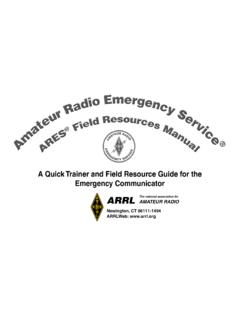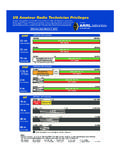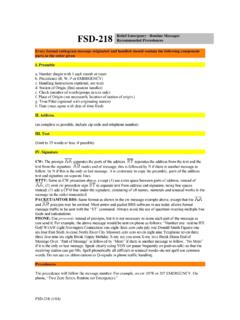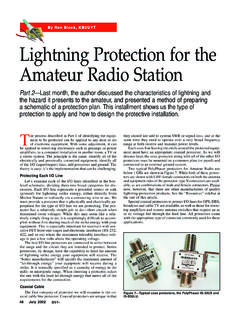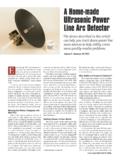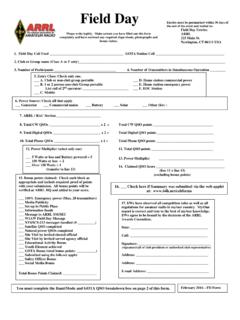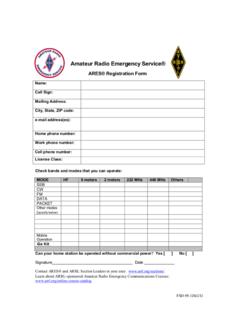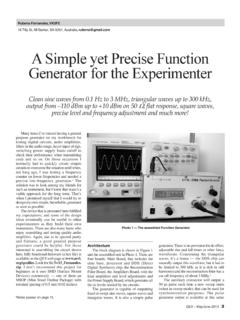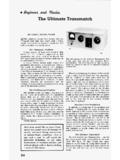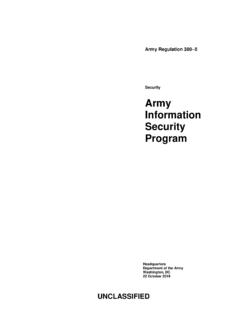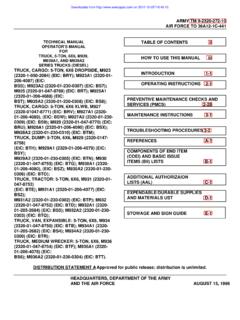Transcription of ares manual 2015 - 2
1 Amateur Radio Emergency Service March 2015. Copyright 2015 by The American Radio Relay League Copyright secured under the Pan-American Convention. International Copyright secured. All rights reserved. No part of this work may be reproduced in any form except by written permission of the publisher. All rights of translation reserved. Printed in USA. First Edition 2015 ISBN: 978-1-62595-029-1. 1. Acknowledgments The Amateur Radio Emergency Service manual Working Group and Contributors Monte Simpson, W7 MLS, Western Washington Section Manager Wayne Gronlund, N1 CLV, Connecticut Section Emergency Coordinator David Greenhut, N6HD, Los Angeles Section Manager Mark Conklin, N7 XYO, Oklahoma Section Emergency Coordinator Dan O'Donovan, W4 DOD, Tennessee Section Emergency Coordinator Ross Merlin, WA2 WDT, United States Department of Homeland Security John McDonough, WB8 RCR, Michigan Section Emergency Coordinator Mike Corey, KI1U.
2 ARRL Emergency Preparedness Manager Ron Hashiro, AH6RH, Hawaii Emergency Management Agency RACES Coordinator and EC. Keith Miller, N9 DGK, Tennessee Section Manager 2. Table of Contents Chapter 1: The Amateur Radio Emergency Service, An Overview ..1. Chapter 2: ARES and the Radio Amateur Civil Emergency Service ..9. Chapter 3: ARES Training ..17. Chapter 4: ARES Mutual Assistance Teams ..22. Chapter 5: ARES Messaging ..26. Chapter 6: The Simulated Emergency Test ..32. Chapter 7: Emergency and Disaster Chapter 8: Working with Partners, Served Agencies, and the Public.
3 38. Memoranda of Understanding Memorandum of Understanding between The American National Red Cross and ARRL, the national association for Amateur Radio ..46. Memorandum of Understanding between The Association of Public-Safety Communications Officials-International, Inc, and the American Radio Relay League, Inc..58. Memorandum of Agreement between The Department of Homeland Security/Federal Emergency Management Agency and The American Radio Relay League, Inc..61. Memorandum of Understanding between The National Weather Service and the American Radio Relay League, Inc.
4 71. Memorandum of Understanding between REACT International, Inc., and The American Radio Relay League, Inc..74. Memorandum of Understanding between The American Radio Relay League, Inc, and the Salvation Army in the United States of America ..76. Incident Command System Forms ISC 205 Incident Radio Communications Plan ..80. ICS 213 General ICS 214 Activity Log ..85. 3. 4. Chapter 1: The Amateur Radio Emergency Service: An Overview The Amateur Radio Emergency Service (ARES ) consists of Amateur Radio licensees who have voluntarily registered their qualifications and equipment for communications duty in the public service when disaster strikes.
5 Every licensed amateur, regardless of membership in ARRL or any other local or national organization, is eligible to apply for membership in ARES. Training may be required or desired to participate fully in ARES. The local ARES Emergency Coordinator can provide specifics. Because ARES is an Amateur Radio program, only licensed radio amateurs are eligible for membership. The possession of emergency-powered equipment is desirable, but is not a requirement for membership. ARES Organization: National Level There are four levels of ARES organization national, section, district, and local.
6 National emergency coordination at ARRL Headquarters is under the supervision of the ARRL Field Services and Radiosport Manager or his/her designee, who is responsible for advising all ARES officials regarding their problems, maintaining contact with federal government and other national officials concerned with amateur emergency communications potential, and in general with carrying out the ARRL's policies regarding emergency communications. These functions are carried out through the ARRL field organization supervisor and the emergency preparedness program.
7 Section Level The Section Emergency Coordinator (SEC) is the assistant to the Section Manager (SM) for emergency preparedness. The SEC is appointed by the SM to take care of all matters pertaining to emergency communications and the Amateur Radio Emergency Service (ARES) on a section-wide basis. The SEC post is one of top importance in the section and the individual appointed to it should devote all possible energy and effort to this one challenging organizational program for Amateur Radio. There is only one SEC appointed in each section of the ARRL Field Organization.
8 Responsibilities: x Encourage all groups of community amateurs to establish a local emergency organization. x Advise the SM on all section emergency policy and planning, including the development of a section emergency communications plan. x Cooperate and coordinate with the Section Traffic Manager so that emergency nets and traffic nets in the section present a united public service front, particularly in the proper routing of Welfare traffic in emergency situations. Cooperation and coordination should also be maintained with other 1. section leadership officials as appropriate, particularly with the State Government Liaison and Public Information Coordinator.
9 X Recommend candidates for Emergency Coordinator and District Emergency Coordinator appointments (and cancellations) to the Section Manager, and determine areas of jurisdiction of each amateur so appointed. At the SM's discretion, the SEC may be directly in charge of making (and canceling) such appointments. In the same way, the SEC can handle the Official Emergency Station appointments. x Promote ARES membership drives, meetings, activities, tests, procedures, etc., at the section level. x Collect and consolidate Emergency Coordinator (or District Emergency Coordinator) monthly reports and submit monthly progress summaries to the SM and ARRL Headquarters.
10 This includes the timely reporting of emergency and public safety communications rendered in the section for inclusion in QST. x Maintain contact with other communication services and serve as liaison at the section level with all agencies served in the public interest, particularly in connection with state and local government, civil preparedness, Federal Emergency Management Agency, American Red Cross, Salvation Army, the National Weather Service, and so on. Such contact is maintained in cooperation with the State Government Liaison. x Section Emergency Coordinators are encouraged to complete ARRL Emergency Communications training Introduction to Emergency Communications (EC-001) and Public Service and Emergency Communications Management for Radio Amateurs.
